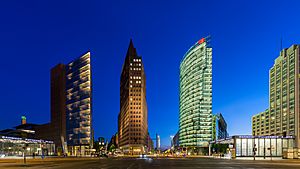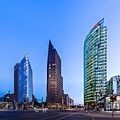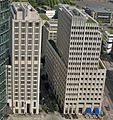Potsdamer Platz facts for kids
Potsdamer Platz is a famous public square and busy traffic hub in Berlin, Germany. It sits right between the old city center in the east and the newer western parts of Berlin. This important area connects to Leipziger Platz nearby. Today, Potsdamer Platz is known for its modern buildings, shops, and entertainment. It's a place where history and modern life meet.
Contents
The History of Potsdamer Platz
Potsdamer Platz has a long and interesting history. For a long time, it was one of the busiest places in Europe. It was a major crossroads for roads and railways.
Early Days and Growth
In the 18th century, Potsdamer Platz was just outside Berlin's city gates. It was named after the city of Potsdam. People traveled through here on their way to and from Potsdam.
By the late 19th and early 20th centuries, the area grew rapidly. It became a lively center for shopping, hotels, and entertainment. Many grand buildings were built here. It was a symbol of Berlin's fast growth and modern spirit.
First Traffic Light in Europe
In 1924, something special happened at Potsdamer Platz. Germany's first traffic light tower was put up here. This helped manage the huge amount of cars, trams, and people. It showed how modern and busy the square had become.
World War II and Destruction
During World War II, Berlin was heavily bombed. Potsdamer Platz was almost completely destroyed. The once-lively square became a pile of ruins. Many famous buildings were gone.
The Cold War and the Berlin Wall
After the war, Berlin was divided. Potsdamer Platz ended up right on the border between East Berlin and West Berlin. This meant it became a desolate, empty space.
When the Berlin Wall was built in 1961, Potsdamer Platz was cut in half. It became part of the "death strip" next to the Wall. This was a guarded area that no one could enter. For nearly 30 years, this once-busy square was empty and quiet. It was a stark reminder of Berlin's division.
Reunification and New Beginnings
In 1989, the Berlin Wall fell. This was a huge moment for Germany. Potsdamer Platz was suddenly open again. It was a large, empty space in the heart of a reunited city.
This empty space offered a unique chance. Architects and city planners could design a whole new district from scratch. It became one of Europe's biggest construction sites.
Modern Development
From the mid-1990s, Potsdamer Platz was rebuilt. Many famous companies and architects helped. Today, it is a modern urban area with many different buildings.
- Sony Center: This is a striking complex with a huge tent-like roof. It has cinemas, restaurants, and offices. It's a popular spot for visitors.
- Daimler-Benz Quarter: This area includes offices, shops, and apartments. It also has the Arkaden shopping mall.
- Kollhoff Tower: This tall brick building offers great views of the city.
Potsdamer Platz is now a vibrant place again. It has cinemas, theaters, restaurants, and shopping malls. It's a popular destination for both Berliners and tourists. It shows how a city can rebuild and reinvent itself after difficult times.
Images for kids
-
Proposed design by Karl Friedrich Schinkel for Potsdamer Platz and Leipziger Platz.
-
Observation deck in West Berlin with a view of Potsdamer Platz on the other side of the Berlin Wall, 1977. At the bottom of the steps is a placard showing what the square looked like in 1929.
-
Looking south over Potsdamer Platz in September 2005. The long green strip is Tilla Durieux Park, the site of the former Potsdamer Bahnhof and its approaches. The Park Kolonnaden development is on its left (eastern) side, while the Daimler development parallels it down the right (west) side. In the left foreground is Leipziger Platz, while in the right foreground are parts of the Sony and Beisheim Centers.
-
The Sony Centre's Bahn Tower, Deutsche Bahn's corporate headquarters at Potsdamer Platz, in 2009.
-
The 2007 Berlinale (aka the Berlin International Film Festival): its principal venue at Potsdamer Platz.
See also
 In Spanish: Potsdamer Platz para niños
In Spanish: Potsdamer Platz para niños














































